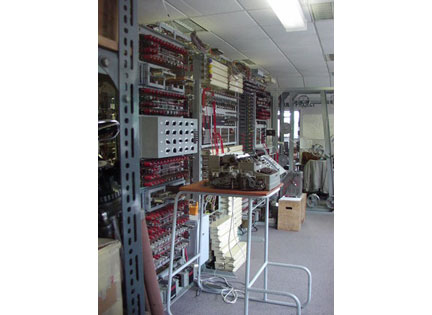Modern PCs to challenge WWII codebreaker

Colossus, the cipher-breaking World War II computer, is to be pitted against modern computing power in a competition organised by the National Museum of Computing.
In an event called the "Cipher Challenge", which is running on Thursday and Friday, the Colossus has to decode radio communications intercepted from Germany. Competing against it and a team from the National Museum of Computing will be radio enthusiasts who will intercept the messages and race against the rebuilt Colossus to decrypt them, using whatever computing means they have at their disposal.
Anthony Sale, who heads up the team which rebuilt the Colossus, said that text in German had been encrypted using a Lorenz teleprinter cipher machine, the same machine which was used by Germany for high-level communications in WWII. "We've enciphered signals on the Lorenz, and a team is transmitting from Paderborn [in Germany]. The signals are being intercepted by stacks of people, and the challenge is to break the cipher before Colossus does."
The Colossus works by comparing two data streams, added Cliff Horrocks, another member of the team that rebuilt the computer. Cipher text on a paper tape is loaded onto the computer and the data is compared with an electronic simulation of the Lorenz machine at different wheel settings. Lorenz machines use differing combinations of wheels to set ciphers. Like the famous Enigma cipher machine, the Lorenz creates the random numbers needed to build a robust cipher.
Once the Lorenz settings are known, the cipher stream is then passed through a machine called "Tunny", which uses the same wheel patterns as the Lorenz machine to decode the message and render it in plaintext. A Tunny machine is currently being rebuilt, so the Colossus team will use a simulated Tunny machine to decipher the message.
"We're comparing the intercepted cipher text [with a simulated] Lorenz machine, to work out the cipher stream," said Horrocks. "We're looking for adjacent German characters using Boolean maths. At every pass of the tape the program is stepped round one character. When we reach a threshold for a match count, we can say with certainty that it is a [Lorenz] setting for a particular run, and the setting is printed."
Colossus computers were built during WWII at British codebreaking centre Bletchley Park, where the National Museum of Computing is now housed. Billed as the first electronic computers, 10 Colossi were eventually built. Sale and his team have spent 14 years rebuilding a Mark II Colossus, which is now installed at Bletchley Park.
"It took 14 years to rebuild, just because of lack of information," said Sale. "All the drawings [of Colossi] were burnt in 1960, so all we had to go on were six black-and-white photos and 10 fragments of circuit diagrams. The machine has 2,500 valves, so it was a challenge piecing it all together."
While the Colossus project remained completely secret during the war and for a period afterwards, the people who contributed to it went on to use their knowledge to design computer systems. Alan Turing moved on to design the Automatic Computing Engine (ACE) in 1945, while Max Newman developed the Manchester Mark 1 computer at Manchester University, the first stored program computer. Tommy Flowers, who had designed and built the first Colossus while working for the Post Office, went back to designing and building Post Office telephone exchange systems.
